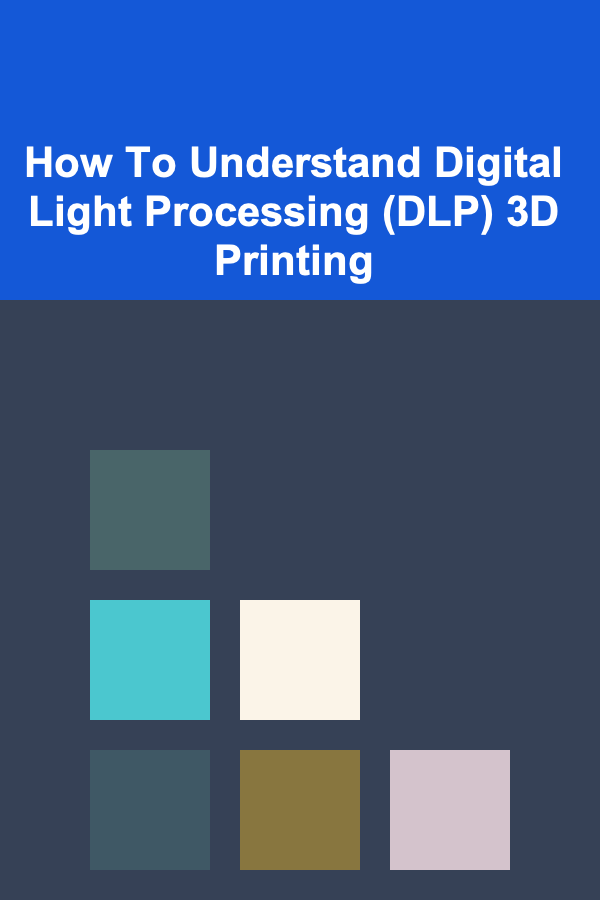
How To Understand Digital Light Processing (DLP) 3D Printing
ebook include PDF & Audio bundle (Micro Guide)
$12.99$9.99
Limited Time Offer! Order within the next:

Introduction to Digital Light Processing (DLP) 3D Printing
Digital Light Processing (DLP) 3D printing is a powerful and innovative technology that has revolutionized the world of additive manufacturing. As one of the most precise and efficient forms of 3D printing, DLP stands out for its ability to create highly detailed and accurate models, often with a smoother surface finish than other 3D printing techniques. This process is widely used in industries such as dentistry, jewelry making, automotive prototyping, and medical device manufacturing, among others.
In this article, we will explore the principles, mechanisms, applications, and benefits of DLP 3D printing, as well as the potential challenges and the future of this technology.
The Basics of DLP 3D Printing
What is Digital Light Processing (DLP)?
DLP is a 3D printing technology that uses a digital projector to cure liquid resin layer by layer, turning it into a solid model. It is similar to another popular 3D printing method called stereolithography (SLA), but the key difference lies in the light source. While SLA uses a laser to cure the resin, DLP employs a digital light projector to simultaneously project an entire layer of the model at once, making the process faster than SLA.
DLP printers are equipped with a projector that emits ultraviolet (UV) light, which is directed onto a resin vat. The liquid resin in the vat contains photopolymer materials that react to UV light, causing them to harden and form solid structures. The printer builds up the model one thin layer at a time, with each layer being exposed to light from the projector. This process continues until the 3D model is fully created.
Key Components of a DLP 3D Printer
A typical DLP 3D printer consists of several essential components that work together to produce high-quality 3D prints:
- Digital Projector: The projector is the core component that generates UV light and projects the pattern of each layer onto the resin. It can vary in resolution, which directly impacts the accuracy and detail of the final print.
- Resin Vat: This container holds the liquid photopolymer resin. The vat is typically transparent, allowing the projector's light to pass through and cure the resin.
- Build Platform: The build platform is where the model is formed. It moves up and down during the printing process, ensuring that each layer is correctly cured and bonded to the one beneath it.
- Resin: The material used in DLP printing is a liquid photopolymer resin that hardens when exposed to UV light. There are various types of resins available, each with its own properties, such as flexibility, rigidity, color, and transparency.
- Controller: The controller manages the 3D printer's operation, including the movement of the build platform, the exposure time of each layer, and the resolution of the printed model.
How DLP Works
The process of DLP 3D printing can be broken down into the following steps:
- Model Preparation: Before printing, a 3D model must be designed using computer-aided design (CAD) software. The model is then sliced into thin horizontal layers using slicing software, which also generates the necessary instructions for the printer.
- Resin Layering: The build platform is submerged in the resin vat, and the first layer of the 3D model is projected onto the resin surface. The UV light from the projector hardens the resin in the shape of the layer.
- Layer Curing: Once the first layer is solidified, the build platform moves up slightly, and a fresh layer of resin is spread over the previous layer. The process is repeated layer by layer until the entire model is complete.
- Post-Processing: After the printing is finished, the model is carefully removed from the build platform. At this point, the print is usually still soft and needs to be cured further in a UV chamber or with additional light exposure to reach its full hardness and strength.
- Cleaning: The printed model is then cleaned to remove any excess resin that may still be on the surface. This can be done using isopropyl alcohol or another cleaning solution. Depending on the resin, the model may also require support removal, as many 3D prints require temporary supports during the printing process.
Advantages of DLP 3D Printing
DLP 3D printing offers several significant advantages that make it appealing for both hobbyists and professionals:
1. High Precision and Detail
One of the primary benefits of DLP printing is its high resolution. Since the entire layer is exposed at once, DLP printers can produce incredibly detailed and accurate models. The projector's resolution often determines the level of detail, with higher resolution projectors producing finer prints. This makes DLP an excellent choice for industries that require intricate designs, such as jewelry, dentistry, and medical modeling.
2. Faster Printing Speed
DLP printers tend to be faster than other 3D printing methods like SLA and FDM (Fused Deposition Modeling). Because a DLP printer projects an entire layer at once, it does not need to trace the contours of each layer individually, as is the case with SLA and FDM. This makes the printing process more efficient, allowing for faster production times, especially when printing large quantities of small models.
3. Superior Surface Finish
Due to the precise control over the light exposure, DLP printers often produce models with smoother surface finishes compared to other 3D printing technologies. The high resolution and uniform layer curing contribute to reduced layer lines, resulting in prints that are closer to the desired final product without the need for extensive post-processing.
4. Wide Material Range
DLP printing supports a variety of materials, including different types of photopolymer resins. There are resins available for a range of applications, from rigid and flexible materials to resins that mimic rubber, ceramics, or even bio-compatible materials. This versatility allows DLP printers to be used in various industries, each with its own material requirements.
5. Lower Operational Costs for Small Runs
While DLP printers can be expensive upfront, they are often more cost-effective for small production runs. The speed and efficiency of DLP printing can help reduce costs in low-volume production, especially for industries that require high precision but do not need large quantities of models.
Applications of DLP 3D Printing
DLP 3D printing has found applications across various industries due to its precision and versatility:
1. Dental Industry
The dental industry has embraced DLP technology due to its ability to create highly detailed and accurate models for crowns, bridges, and dentures. The precision of DLP allows for precise fit and detail, which is crucial for dental applications. Additionally, DLP printers can create molds for prosthetics, orthodontic devices, and surgical guides.
2. Jewelry Manufacturing
DLP printing is also widely used in the jewelry industry to produce intricate designs and molds. The high resolution of DLP printers allows jewelers to create fine details, such as filigree patterns, which would be difficult to achieve with traditional methods. DLP technology is often used to produce wax patterns for casting, which can be melted away to create the final metal pieces.
3. Prototyping and Product Design
DLP is ideal for creating prototypes and models during the product design phase. Its ability to produce highly accurate models allows designers to quickly evaluate form, fit, and function before moving to the next stage of development. This helps reduce development time and costs, especially for industries like automotive and electronics.
4. Medical Device Manufacturing
The medical field has seen significant advancements with DLP printing, especially in creating custom implants and surgical guides. The high precision of DLP allows for the production of patient-specific models, such as custom-fit prosthetics and implants, which improve patient outcomes.
Challenges and Limitations of DLP 3D Printing
Despite its many advantages, DLP printing does come with a few challenges and limitations:
1. Material Limitations
Although DLP printers can use a wide range of materials, there are still limitations in terms of material properties. For example, DLP resins may not always offer the same strength and durability as materials used in other 3D printing methods, such as metal or thermoplastic materials. Additionally, resin materials can be expensive compared to filament-based materials, which may make DLP less suitable for large-scale production.
2. Build Size Restrictions
DLP printers typically have smaller build volumes than other 3D printing methods like FDM or SLA. While this is not an issue for creating small, intricate models, it can be a limitation when larger models are required. However, advancements in DLP technology are working towards increasing build size without sacrificing resolution.
3. Post-Processing Requirements
DLP prints require extensive post-processing, including washing and curing. While DLP prints are faster than SLA or FDM prints, the cleaning and curing process can still be time-consuming, particularly when dealing with small details or larger models. Additionally, the supports used during printing must be removed, which can be labor-intensive.
The Future of DLP 3D Printing
As DLP technology continues to evolve, several trends and innovations are expected to shape the future of this 3D printing technique:
1. Improved Speed and Efficiency
Ongoing advancements in projector technology, resin formulations, and hardware design are likely to make DLP printers even faster and more efficient. As manufacturers continue to optimize the printing process, it is expected that production times will continue to decrease while maintaining the high precision that DLP is known for.
2. Better Material Options
The development of new resin materials will allow DLP printing to expand its use in different industries. Future materials may offer better mechanical properties, including increased strength, flexibility, and resistance to wear. Additionally, more biocompatible resins may make DLP printing even more valuable in medical applications.
3. Larger Build Volumes
With the constant push for larger and more versatile 3D printers, we can expect to see DLP printers with larger build volumes. This will open the door for new applications, including large-scale manufacturing and the creation of larger models in industries like automotive and aerospace.
4. Integration with Other Technologies
DLP printing may also see greater integration with other technologies, such as robotics, automation, and artificial intelligence, to further streamline the manufacturing process and enable faster production of complex parts.
Conclusion
Digital Light Processing (DLP) 3D printing has proven itself to be a powerful tool in the world of additive manufacturing. With its ability to produce high-quality, precise, and detailed models quickly, DLP has become indispensable in industries ranging from dentistry to jewelry making, prototyping, and medical device manufacturing. While there are some challenges to overcome, the future of DLP looks promising, with continuous advancements in speed, material variety, and build volume.
As DLP technology matures, it will likely find even more applications, pushing the boundaries of what is possible in 3D printing. Whether you are a hobbyist, designer, or professional in any of the industries mentioned, understanding the fundamentals of DLP can help you take full advantage of its capabilities and prepare for its future impact on the world of manufacturing and design.
Reading More From Our Other Websites
- [Home Renovating 101] How to Use Smart Home Devices for Renovations to Optimize Project Management
- [Whitewater Rafting Tip 101] Streamlined Strength: Transform Your Body with These Rafting-Focused Training Tips
- [Organization Tip 101] How to Incorporate Natural Elements into Your Wellness Space
- [Personal Care Tips 101] How to Use a Fitness Tracker to Maximize Results
- [Survival Kit 101] How to Create an Emergency Survival Kit for Suburban Families Near Wildfire Zones
- [Gardening 101] From Rustic Stone Paths to Modern Minimalist Walkways: Styles to Inspire
- [Organization Tip 101] How to Use Project Management Tools for Paperwork Control
- [Organization Tip 101] Step-by-Step Guide to Applying Self-Leveling Underlayment
- [Home Lighting 101] How to Install Smart Lighting to Enhance Your Home's Ambiance
- [Home Budget 101] How to Save Money on Home Heating and Cooling Costs

How to Create Engaging Content That Attracts Followers
Read More
How to Leverage Technology to Track Your Financial Progress
Read More
How To Negotiate Your Salary Like a Pro
Read More
How To Combat Rosacea Redness with Calming Products
Read More
How to Pick a Padlock: A Beginner's Guide
Read More
**How to Knit with Multiple Colors: A Step-by-Step Tutorial**
Read MoreOther Products

How to Create Engaging Content That Attracts Followers
Read More
How to Leverage Technology to Track Your Financial Progress
Read More
How To Negotiate Your Salary Like a Pro
Read More
How To Combat Rosacea Redness with Calming Products
Read More
How to Pick a Padlock: A Beginner's Guide
Read More